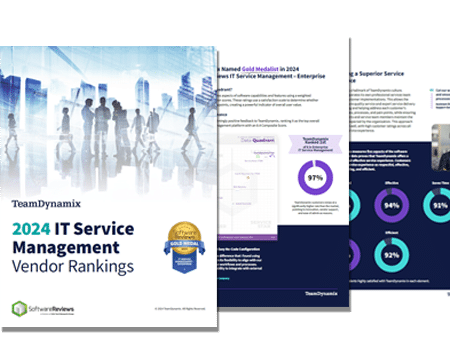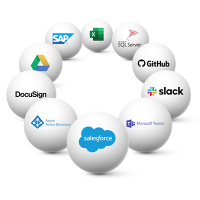
Understanding Change Management and Its Importance Within Your Organization
Did you know that a significant number of IT incidents occur when someone makes a change to one system that then affects other systems in

The Info-Tech ranking report offers a unique view of the market based entirely on in-depth customer interviews. Download the Info-Tech ITSM Quadrant and Customer Viewpoint report today.

We’ll show you some of our best situations and show you exactly how to execute them to get immediate results. The best part is, iPaaS tools often feature easy-to-use click and drag functionality, meaning you don’t need a dedicated employee building integrations and workflows.

System Integrators, Value Added Resellers, Technology Providers, and Buying Consortiums can benefit from a partnership with TeamDynamix.

The Info-Tech ranking report offers a unique view of the market based entirely on in-depth customer interviews. Download the Info-Tech ITSM Quadrant and Customer Viewpoint report to gain a better understanding of key vendor strengths and emerging market requirements.
According to a study completed between TeamDynamix and IDG, the average company uses 185 apps and manages hundreds of APIs. With the rise of cloud-based SaaS offerings, each department within an organization is now empowered to build its own, unique tech stack to simplify and track its processes and data. From HR to marketing, sales to finance, facilities to security… it goes on and on.
Chances are each area uses anywhere from 10 to 50 different systems to do business. While this, undoubtedly, has made companies, on the whole, more productive – it’s also created tech silos within organizations.
This fragmentation of data and technology usually means there’s little transparency across departments about what tools are in use, what data is being collected and where that data moves and gets stored. This is a BIG problem.
To help eliminate these tech silos, businesses are investing in an emerging tech – enterprise integration platform as a service, iPaaS.
iPaaS enables businesses to bring together all applications and APIS on a single platform AND create workflows to automate both simple and complex processes across tools and departments. This can save you both valuable time and resources, as well as improve cross-department communication around the tools being used and the data being collected, moved and stored by your organization.
IT organizations especially can greatly benefit from iPaaS as IT Service Management (ITSM) generally relies heavily on manual processes, which can be time-consuming, expensive and error-prone.
iPaaS can automate many of these processes, freeing up IT staff to focus on more strategic initiatives. In addition, iPaaS can provide a unified view of an organization’s IT infrastructure, making it easier to identify and resolve problems.
Finally, iPaaS can help to reduce the risk of IT outages by quickly and efficiently integrating new applications and components into the existing IT landscape. As a result, iPaaS can provide significant benefits for IT organizations within companies.
When talking about the benefits iPaaS brings to an organization, Mark Hayes, information technology leader at Pima County, highlights automation and the reduction of “toil.”
“The drudgery of working through mundane, repetitive tasks doesn’t exist just in IT,” Hayes said. “I think the more we can reduce toil within the departments that we support, the more people are going to buy in and understand the value of what we’re trying to achieve. There’s nothing like success to breed more success, and once other departments see the benefits they’re going to want these tools too.”
And with many organizations struggling to maintain or hire new talent, especially in IT, iPaaS can play a critical role in improving efficiencies and employee satisfaction, “People feel so much more empowered and have so much more worth when they are doing things that are intellectually rigorous and challenging versus when they are just repeating the same mechanical actions over and over and over with very little thought,” Hayes said.
Here are some additional benefits businesses can take advantage of when using an iPaaS solution.
Cost can be a big prohibitor when researching new technology for an organization – especially when budgets are tight and resources to implement and run the new technology are limited.
The great thing about some iPaaS options, like TeamDynamix iPaaS, is they offer predictable pricing and unlimited usage.
TeamDynamix iPaaS provides this low price point and the ability to connect any number of applications without a corresponding increase in cost per application. Once an integration workflow is launched, your cost won’t grow with usage and the easy-to-use functionality means you don’t need a large team of developers to maintain your integrations.
At Metropolitan State University the price point of TeamDynamix iPaaS was a big draw.
“We were using a different iPaaS tool before and it took a lot of time to spin up and it became really expensive for what we were hoping to do with it,” Deneen said. “It was fine for connecting macro systems, but we couldn’t scale it the way we wanted.”
With TeamDynamix iPaaS, Deneen is not having the same issues. In fact, they’ve been able to move quickly with the new iPaaS tool and use it to integrate all their systems from their old ERP to Workday, Active Directory and more.
“We’re able to easily spin up these connections and make it turnkey so anyone can use it,” Deneen said.
Many iPaaS tools are no code or low code, meaning you don’t need to be a programmer to set up workflows and automation. Lines of business and various departments can build their own workflows while enterprise systems teams can be confident that the right guardrails, governance and security requirements are in place.
As lines of business grow, they can independently and quickly deploy and manage their integrations without needing more support from enterprise IT. As a result, business professionals in various lines of business can become self-serving for their integration and automation needs without requiring additional headcount or an increase in IT budgets.
When TeamDynamix first released iPaaS, Western University of Health Sciences was one of the first organizations to purchase and use it. iPaaS is an integration and automation platform that helps organizations bring together data from disparate systems and drive workflows for both simple and complex processes across multiple systems.
“We definitely jumped at the opportunity to get iPaaS,” David Mitchell, Enterprise Application Administrator, said. One of the key objectives for Mitchell and his team has been finding ways to save technicians time and make them more efficient – iPaaS lends itself nicely to that.
“We are looking at what can save our technicians time, what are we already doing that may be more efficient with iPaaS and what systems we need to integrate with iPaaS,” he said.
WesternU started by automating simple tasks with iPaaS, things like automatic VPN access for approved users, keeping assets up to date and reconciling data between Active Directory and Banner. “A lot of these tasks aren’t tasks that are necessarily hard for anyone to do manually, it’s more that they are repetitive and time-consuming.”
By automating tasks, especially the repetitive ones, Mitchell said their technicians now have time to focus their attention on bigger issues. “We’ve been working in iPaaS since January and I feel like we’ve already come a long way and are saving time,” he said. “But there’s so much more we can do.”
For Mitchell, the codeless drag-and-drop functionality of iPaaS has really enabled him and his team to move quickly and creatively when it comes to building new workflows.
“I’m not a programmer at all,” Mitchell said. “I don’t know the programming languages, I’m kind of illiterate when it comes to that, but I like to call iPaaS Lego programming because you just snap everything together and it works.”
Aside from cost and ease of use, iPaaS allows you to make better business decisions, cuts down on integration technical debt and can help you manage both employee and app churn.
By using a single platform, you get a unique view of all the data moving within your organization. iPaaS works seamlessly in the background moving data between applications with the right governance in place so that you can empower your company to make better and quicker decisions. All the data needed is at your fingertips.
In contrast, legacy tools often result in slower decisions or decisions with incomplete data, as teams scramble to pull together information upon request.
In terms of technical debt and security, using a modern integration and automation platform, like iPaaS, teams can become agile and flexible partners to their business teams and avoid the cost of technical debt.
The full-featured, quick-to-build and deploy nature of iPaaS allows organizations to avoid the bloat that can come when trying to build integrations in-house. In addition, the state-of-the-art enterprise security features of iPaaS can provide your organization with the kind of bulwark it needs against costly breaches and other risks – a key feature for any business relying on hundreds of APIs.
Finally, iPaaS helps manage employee churn and supports app growth and churn. A big problem for many organizations happens when a key employee leaves the company. Often a brand-new employee is tasked with taking over the former employee’s integration and automation work.
However, if using older technology or in-house custom code, there’s a need for extensive documentation to bring the new employee up to speed. And if there’s no documentation they are left to try and figure out things on their own.
As iPaaS is built for ease of use and team collaboration, it’s easy for new employees to quickly pick up and accelerate the organization’s automation strategy.
Much like employee churn, app churn can present issues for an organization. As an organization’s app usage grows, enterprise teams need to be able to quickly deploy and launch new integrations and workflows.
At the same time, we are also seeing a consistent churn in the applications used by companies with some companies churning through 30% of their applications in a year as their needs evolve. Enterprise teams need to be able to keep up with the pace of growth as well as sunset various applications.
Using older integration tools or writing custom code in-house is not effective in managing this dynamic situation, whereas iPaaS is built for this quick and flexible use of integrations.
To learn more about iPaaS and get tips on picking the right vendor check out our iPaaS buyer’s guide.
This post was originally posted in October 2021 and has been updated with new information.

Did you know that a significant number of IT incidents occur when someone makes a change to one system that then affects other systems in

The construction industry can be very volatile, with a high employee turnover rate due to seasonal fluctuations in the workforce. A key challenge for the

A study from Information Week and TeamDynamix shows companies are looking to invest in IT Service Management (ITSM) software that is simple to administer and
TeamDynamix’s award-winning SaaS cloud solution offers IT Service and Project Management together on one platform with enterprise integration and automation.
[email protected]
(877) 752-6196
Contact Us
